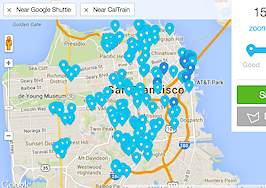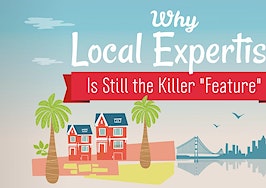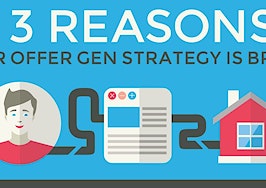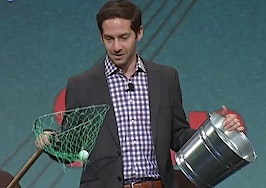- A low-inventory market typically indicates a seller's market, which means sharply rising prices, a torrent of offers on every home and discouraged crowds of battle-beaten homebuyers.
- The top 1 percent buyer's agents in San Francisco aren't just making do with a brutal market -- they're positively thriving.
- The top 1 percent buyer's agents in SF aren't usually putting in the highest bid, but they're definitely putting in the effort to make their offers unforgettable.
If you’re a broker or an agent in any booming metropolitan area, you’ve heard the excuse over and over again: “It’s a low-inventory market.”
Granted, a low-inventory market typically indicates a seller’s market, which means sharply rising prices, a torrent of offers on every home and discouraged crowds of battle-beaten homebuyers.
Yes, for a homebuyer, a low-inventory market is far from ideal.
For an agent, conventional wisdom dictates that you should focus on getting listings during a low-inventory market — it’s a guaranteed quick close at a high price.
Consequently, agents shy away from aggressively pursuing buyers because they know that a difficult offer battle lies ahead.
But this isn’t the full picture. You might be missing out on massive opportunities by de-emphasizing buyers in a low-inventory market.
We talked to a group of top 1 percent buyer’s agents in the hottest, toughest and lowest-inventory market in the U.S. today: San Francisco. And what we heard blew us away.
These agents aren’t just making do with a brutal market — they’re positively thriving. Many are seeing the best production of their careers and show no signs of slowing down.
So what’s their secret? What strategies are they using to turn a disadvantage to an advantage? Why are agents such as Cece Doricko of Coldwell Banker exclaiming “Best year ever”?
Better buyer education equals more transactions
The most commonly repeated advice from the top 1 percent producers was to invest heavily in buyer education. “Better-prepared buyers get more offers closed,” said Tanya Dzhibrallova of Zephyr Real Estate. “You have to give it straight to your clients, even if it is not what they want to hear.”
Especially in a low-inventory market, it’s critical for you and your client to be on the same page about communication practices, price expectations and winning strategies. No buyer wants to hear that they have to offer above asking price to be competitive.
But you’re not doing them — or yourself — any favors by shielding them from the truth. Ultimately, you might have to drop clients who are unwilling to be educated.
[Tweet “You have to give it straight to your clients, even if it is not what they want to hear.”]
Offer acceptance: Not about the money
It’s unavoidable to go above the listing price in the hottest markets, but that doesn’t mean the highest offers always get accepted. In fact, the top 1 percent agents in San Francisco aren’t usually putting in the highest bid, but they’re definitely putting in the effort to make their offers unforgettable.
“It is a mistake to not have a cover letter and personal letter included in your offer package,” shared Nina Hatvany of Pacific Union. “It makes it very dry reading otherwise.”
Despite everything, a personal touch still seems to make a big difference. “Whenever I can, I try to get my buyer to meet the seller. There’s no better way to solidify the offer’s emotional appeal,” said Missy Wyant Smit of Hill & Co.
Another overlooked element of winning offers is timing. “It’s never worth it to rush an offer,” explains Suzy Reily of Zephyr Real Estate. “Clerical errors or neglecting the fine print is the fastest way to lose out on a competitive bid.”
How do you ensure quality paperwork? Attention to detail is obviously important, but keeping your buyers abreast of new inventory is also crucial, especially when days-on-market is so short. If they move too late to put in an offer, the rush to send in paperwork can result in errors, which can cost you the deal.
Buyer fatigue is a real issue
A recurring and legitimate challenge for agents in a low-inventory market is homebuyer fatigue. Understandably, having your eighth offer rejected can take the wind out of a buyer’s sails, and it can be a strain on both buyer and agent.
However, Andrea Swetland of Pacific Union explains the importance of persistence: “Someone needs to tell discouraged homebuyers not to give up until they find their dream home — I am that person for them.”
In fact, one of Andrea’s buyers, fatigued out after six failed offers, came to talk to Andrea about dropping out. Andrea’s cheerleading at that meeting encouraged them to put in one more offer, and the seventh time was the charm — two days later, they were in escrow.
Don’t forget, higher prices are good for buyer’s agents, too
It’s easy to forget that one of the advantages for any agent in a low-inventory market is rising prices. Especially in markets that have seen prices rise above 50 percent in the past few years, your economic benefit calculation is simple.
Does it take more work to close a deal in a competitive market? Yes. But a bigger commission check should more than make up for your time.
[Tweet “With the right mindset and strategies, a low-inventory seller’s market can become paradise.”]
To summarize, make sure you:
- Educate your clients
- Craft the best possible offer
- Are mindful of homebuyer fatigue
- Know that the payoff will be worth it
It’s not easy to have the dedication and commitment that these top 1 percent agents demonstrate in their markets, but it’s not through any magical shortcut or inherent advantage that these agents are finding great success.
“It’s never just about closing a deal,” John LePage of Zephyr said. “Happy clients are the most important.”
Simple but powerful advice.
With the right mindset and strategies, any market, but especially a low-inventory seller’s market, can become your very own buyer’s paradise.
Andrew Flachner is the CEO at RealScout, the collaborative home search platform that empowers real estate agents to close more deals faster. He is also author of the Offer Generation Playbook.




